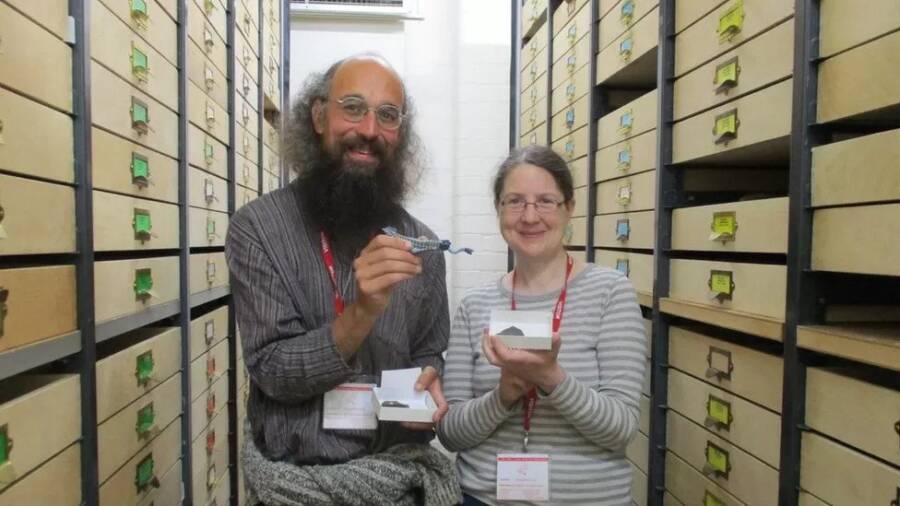These tiny marine fossils date back 460 million years, when an ocean covered the entirety of Wales.
National Museum WalesA depicting of the Modern specie , dubbedMieridduryn bonniae .
While excavating a sheep field in Llandrindod Wells , Powys , Wales , researchers come across two delicate , 460 - million - year - old fossil that date back to when an ocean covered the country . Though scientist believe that they resemble an out nautical life form call opabiniids , they think that the fossils represent a make Modern species .
Asphys.orgexplains , investigator Joseph Botting and Lucy Muir , familiar at the National Museum Wales , made the exciting find during the COVID-19 lockdown .

National Museum WalesA depiction of the new species, dubbedMieridduryn bonniae.
“ When the lockdown embark on , I thought I ’d make one more slip to collect some last sponge before finally compose them up , ” Botting explained . “ [ O]f course , that was the 24-hour interval that I found something sticking its tentacles out of a thermionic tube instead . ”
“ This is the sort of thing that paleontologists ambition of , sincerely soft - consistence preservation , ” Muir added . “ We did n’t slumber well that nighttime . ”
In a study print inNature Communications , the researcher excuse that they ’d base two fossils while excavating the field , a known source for ancient quick study . One was about half an inch long , while the other was just 0.1 inches . Though the smaller specimen has not been named pending further research , the researchers dubbed the large fossilMieridduryn bonniae .

National Museum WalesDr. Joseph Botting and Dr. Lucy Muir are Honorary Research Fellows at Amgueddfa Cymru, National Museum Wales.
National Museum WalesDr . Joseph Botting and Dr. Lucy Muir are Honorary Research Fellows at Amgueddfa Cymru , National Museum Wales .
The first one-half of its name is Welsh for “ bramble snouts ” ( mier , means bramble , and duryn , means snout ) , a nod to the puppet ’s spiked nose . The 2nd half of its name is an court to Bonnie , the niece of the proprietor of the field where Botting and Muir found the fossils .
“ Many scientific names are made using Latin or Grecian words , ” Muir explain to phys.org , “ but we really wanted to abide by Wales , where the specimen were discovered , and so chose to use the Welsh language . ” She added that Bonnie had been supportive and commit in their research .

National Museum WalesThe smaller of the two specimens, measuring just one-tenth of an inch long.
National Museum WalesThe smaller of the two specimen , measuring just one - tenth of an inch long .
So what exactly are the fossils that Botting and Muir regain ? harmonise toLive scientific discipline , they bear some resemblance to “ weird wonders ” called opabiniids , extinct marine creature that emerged during the Welsh explosion .
But the Welsh specie , who lived during the Ordovician period ( some 485.4 million to 443.8 million year ago ) , are 40 million long time young than opabiniids and have some significant differences . M. bonniaehas no eye , for example , whereas opabiniids usually have five eyes . What ’s more , M. bonniaehas a spiky snout , whereas opabiniids have smooth snouts .

National Museum WalesThe curious specimens were found in a Welsh quarry known for yielding ancient sponges — and researchers are eager to keep searching it for more fossils.
“ It could be an opabiniid , ” Joanna Wolfe , a enquiry associate in the Department of Organismic and Evolutionary Biology at Harvard University who co - author the new study , toldLive Science . “ [ But ] maybe it ’s neither an opabiniid nor a radiodont — it ’s kind of in between . ”
National Museum WalesThe curious specimen were found in a Welsh fair game known for give ancient sponges — and researchers are eager to keep search it for more fossils .
In fact , the researchers have speculated that the dodo might be more like arthropod , a group that admit innovative crab , spider , and millipede .
“ The best - stomach locating for our Welsh specimens , whether considered as one or two species , were more closely related to modern arthropods than to opabiniids , ” Stephen Pates of the University of Cambridge , the study ’s jumper lead generator , told phys.org . “ These analyses intimate thatMieriddurynand the smaller specimen were not ‘ true ’ opabiniids . ”
The researchers also hypothesized that the minor of the two fossils could be larvae of the largerM. bonniaespecimen .
“ The size of the smaller specimen is comparable to some modern arthropod larva — we had to take into report this possibleness in our psychoanalysis , ” Wolfe explained to phys.org .
Whatever the Welsh dodo are , they represent an important link in evolutionary life on Earth . And Botting and Muir are eager to retort to the sheep orbit to look for more evidence of ancient life . As Muir joke to phys.org , even modern - day mammal seem connive by their enquiry .
“ Even the sheep know we are on to something special here , ” she order , “ they usually come to catch . ”
After reading about the fogey found in a Welsh sheep field , see how lapin burrowing on Wales’Skokholm Island uncovered a treasure trove of Stone Age artifacts . Then , determine about planet Earth’smost astounding prehistoric creature .